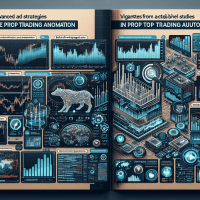Proven Prop Trading Automation: Advanced Strategies That Deliver
Prop trading automation today is not just about leveraging technology – it’s an essential strategy to ensure systematic, risk-managed trading. In this comprehensive guide, we dive deep into advanced prop trading automation techniques, featuring rigorous backtesting methods, detailed tool comparisons, and regulatory insights that empower both junior traders and senior quants. If you are seeking to refine your strategy, optimize your risk metrics, and stay compliant with current financial regulations, this guide is your go-to resource.
Key Strategies for Successful Prop Trading Automation
Effective prop trading automation begins with solid backtesting. Traders can refine strategies, optimize parameters, and conduct stress testing to ensure robust performance across market regimes. In particular, advanced techniques such as walk-forward analysis and out-of-sample testing are essential to avoid common pitfalls like overfitting.
Backtesting Best Practices
To cultivate a reliable automated trading strategy, consider the following methods:
- Utilize Out-of-Sample Testing: Validate your strategy beyond the historical data used in development to mitigate overfitting.
- Implement Walk-Forward Testing: Regularly recalibrate strategies with incremental data updates to simulate real-market conditions.
- Incorporate Stress Testing: Examine performance under volatile market scenarios to ensure the strategy holds during downturns.
Combining these practices with automated parameter optimization is crucial in achieving a balanced and adaptive trading strategy.
Automated Parameter Optimization
Platforms like MetaTrader 5 and QuantConnect offer sophisticated engines for parameter optimization. They automatically run multiple simulations to fine-tune entry/exit points, handle commissions and slippage, and generate comprehensive performance reports. Pro Tip: Leverage scenario analysis features to see how adjustments perform across different market conditions.
Advanced Comparison of Backtesting Tools for Prop Trading
Choosing the right tool is fundamental when integrating automation into prop trading. Below is an in-depth analysis of leading platforms:
| Tool | Backtesting Features | Data Quality & Coverage | Integration | Pricing & Tiers | Use Cases |
|---|---|---|---|---|---|
| TradingView | Vectorized backtesting, custom script alerts, automated indicator integration | Extensive historical data across multiple asset classes | API integration for broker connectivity and real-time feeds | Free tier available; premium plans unlock advanced features | Well-suited for both retail traders and prop trading firms requiring quick insights |
| MetaTrader 5 | Event-driven testing, automated optimization, stress testing with realistic commission/slippage simulation | High-quality forex data with extensive historical records | Direct broker integration and support for third-party plugins | Generally free, with premium data feeds as an optional expense | Favored by prop trading firms in forex markets |
| NinjaTrader | Robust strategy tester, simulation capabilities, and extensive parameter scans | Reliable futures, forex, and equity data (both live and historical) | API integration and connectivity with multiple brokers | One-time purchase or subscription models with free trials available | Ideal for high-frequency strategies and systematic trading approaches |
| QuantConnect | Lean engine for automated backtesting, walk-forward analysis, and out-of-sample testing | Global data feeds with detailed asset class coverage | Cloud-based platform with API access for automated deployments | Community version available, professional subscriptions for advanced use | Best suited for quantitative strategies in large-scale prop trading environments |
Case Studies: Real-World Applications of Prop Trading Automation
An established prop trading firm utilized NinjaTrader and QuantConnect to automate a scalping strategy in the forex market. The firm faced significant challenges due to high false signal occurrences during volatile periods. By integrating automated parameter optimization and combining it with rigorous out-of-sample testing, they:
- Reduced False Signals: Enhanced data quality and optimized system parameters minimized overfitting.
- Improved Risk Metrics: Achieved a 15% higher Sharpe ratio and reduced drawdowns by 20%.
- Streamlined Compliance: Automated reporting ensured adherence to MiFID II and NFA guidelines.
This example illustrates not only how technology drives efficiency but also how essential proper backtesting is to ensure robust trading performance in a regulated environment.
Regulatory and Compliance Considerations
Prop trading automation must align with regulatory frameworks such as MiFID II in Europe, NFA in the United States, and ESMA guidelines. Automated systems should maintain detailed audit trails, risk management logs, and compliance reports. Tools integrating these features, like MetaTrader 5, help traders and firms meet legal requirements while optimizing trading performance.
Integrating Compliance into Automated Systems
Modern backtesting platforms offer in-built compliance features. These include automated logging of trades, error tracking, and customizable risk thresholds which are essential for internal audits and meeting regulatory standards.
Integrating Forward Testing with Automated Backtesting
Although backtesting provides an historical perspective, forward testing (or paper trading) bridges this gap by simulating live market conditions. This two-pronged approach helps confirm that strategies perform consistently in real trading scenarios. Industry Insight: Many top prop trading firms integrate forward testing into their workflow to detect discrepancies early and further refine their strategies before full deployment.
Step-by-Step Guide to Implementing Your First Automated Strategy
For those eager to integrate automation into their prop trading strategy, consider the following steps:
- Define Your Strategy: Clearly specify your entry, exit, and risk management criteria, ensuring they are quantifiable.
- Select a Suitable Tool: Choose a platform that meets your data, integration, and automation needs. For instance, use TradingView for visual charting, MetaTrader 5 for forex, or QuantConnect for complex strategies.
- Conduct Rigorous Backtesting: Leverage both traditional backtesting and walk-forward analysis to validate your strategy across different market conditions.
- Transition to Forward Testing: Move to a paper trading environment to confirm the strategy’s performance under live conditions.
- Incorporate Compliance Protocols: Use built-in features of your platform to track audit logs and manage risk, ensuring regulatory adherence.
These steps lay the groundwork for a scalable, compliant, and efficient prop trading automation process.
Expert Guidance on Avoiding Advanced Backtesting Pitfalls
Common pitfalls such as look-ahead bias and data snooping can significantly distort backtesting results. Here are expert recommendations:
- Use High-Granularity Data: Whenever possible, use tick data instead of aggregated bar data to avoid missing short-term volatility effects.
- Regularly Update Historical Sources: Ensure that the data used in backtesting is up-to-date and reflects any corporate actions that may affect asset prices.
- Implement Multi-Source Testing: Combine data from different providers to help balance biases and reinforce test robustness.
Internal Resources and Next Steps
To further enhance your prop trading strategy, consider exploring our related articles on Advanced Prop Trading Risk Management and Backtesting Strategies for Prop Firms. Additionally, our comprehensive Risk Management Checklist is available for download and includes:
- Defined risk exposure per trade
- Maximum drawdown limits
- Automated stop-loss and take-profit triggers
- Compliance and audit monitoring protocols
- Regular performance reviews integrating forward testing data
Implementing these advanced techniques will not only enhance your trading precision but also ensure that your strategies remain compliant and resilient.
Conclusion: Elevate Your Prop Trading with Automation
As of







